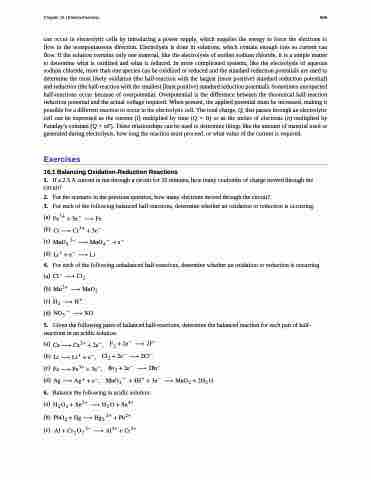Page 899 - Chemistry--atom first
P. 899
Chapter 16 | Electrochemistry 889
can occur in electrolytic cells by introducing a power supply, which supplies the energy to force the electrons to flow in the nonspontaneous direction. Electrolysis is done in solutions, which contain enough ions so current can flow. If the solution contains only one material, like the electrolysis of molten sodium chloride, it is a simple matter to determine what is oxidized and what is reduced. In more complicated systems, like the electrolysis of aqueous sodium chloride, more than one species can be oxidized or reduced and the standard reduction potentials are used to determine the most likely oxidation (the half-reaction with the largest [most positive] standard reduction potential) and reduction (the half-reaction with the smallest [least positive] standard reduction potential). Sometimes unexpected half-reactions occur because of overpotential. Overpotential is the difference between the theoretical half-reaction reduction potential and the actual voltage required. When present, the applied potential must be increased, making it possible for a different reaction to occur in the electrolytic cell. The total charge, Q, that passes through an electrolytic cell can be expressed as the current (I) multiplied by time (Q = It) or as the moles of electrons (n) multiplied by Faraday’s constant (Q = nF). These relationships can be used to determine things like the amount of material used or generated during electrolysis, how long the reaction must proceed, or what value of the current is required.
Exercises
16.1 Balancing Oxidation-Reduction Reactions
1. If a 2.5 A current is run through a circuit for 35 minutes, how many coulombs of charge moved through the circuit?
2. For the scenario in the previous question, how many electrons moved through the circuit?
3. For each of the following balanced half-reactions, determine whether an oxidation or reduction is occurring.
(a) ���� � ��� � ��
(b) �� � ���� � ���
(c) ������ ������ ���
(d) ��� � �� � ��
4. For each of the following unbalanced half-reactions, determine whether an oxidation or reduction is occurring.
(a) ��� � ���
(b) ���� � ����
(c) �� � ��
(d)���� ���
5. Given the following pairs of balanced half-reactions, determine the balanced reaction for each pair of half- reactions in an acidic solution.
(a) ������������ ������ ����
(b) ���������� ������� �����
(c) ������������ ������� �����
(d) ���������� ����� �������� ����������
6. Balance the following in acidic solution:
(a) ���� ����� � ��������
(b) ������������������
(c) ���������� ����������


